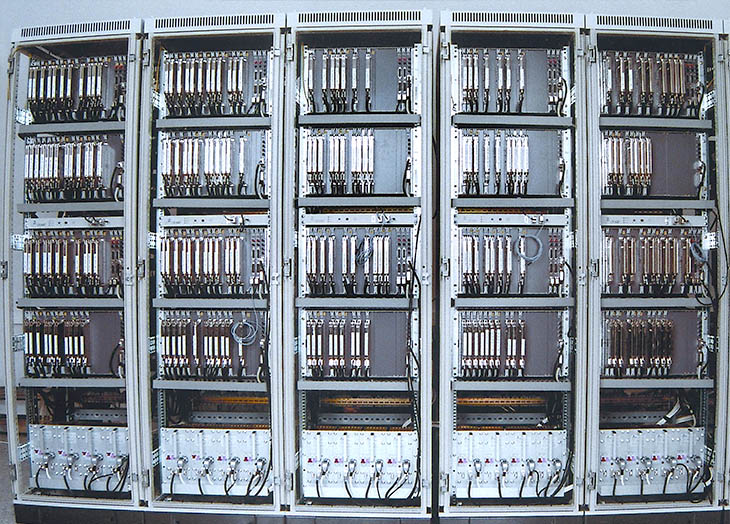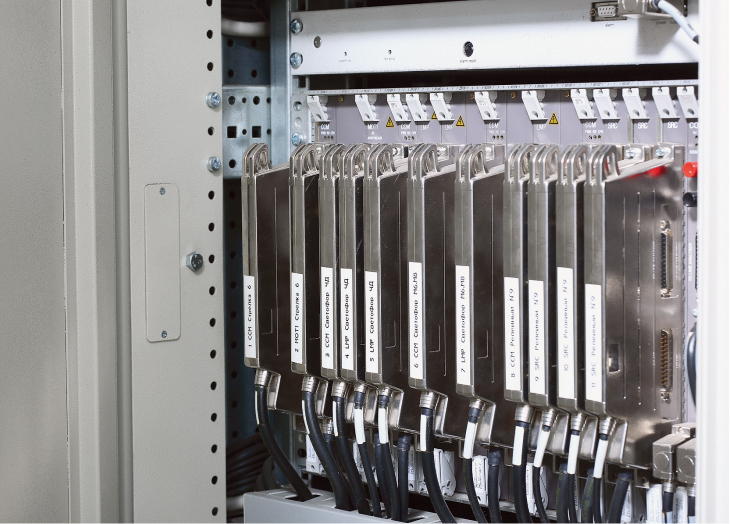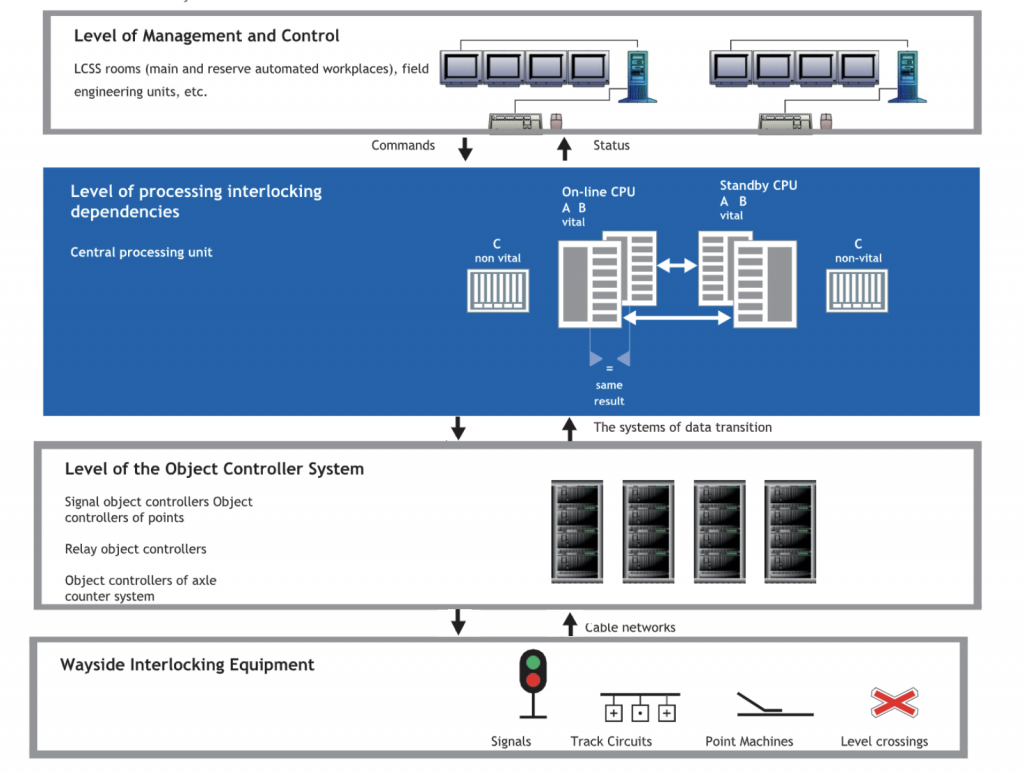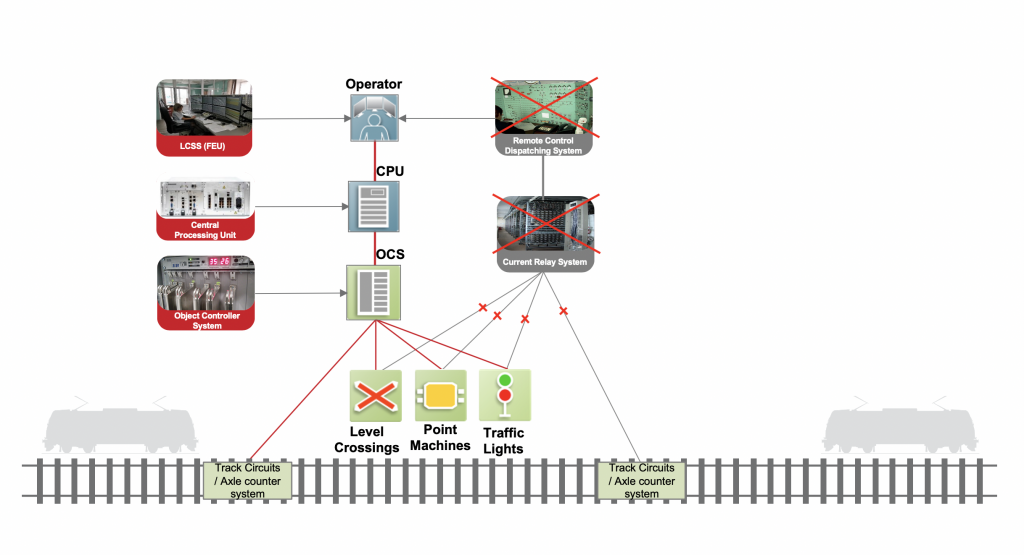
POINT MACHINES
RAIL Switch 100
Console Point Machine for Mainline and Industrial Transport
RAIL Switch 200
Console Point Machine for High-Speed Mainline
RAIL Switch 300
Nontrailable Point Machine of Sleeper-Mounting Design
The CBI system offered by 1520 Signal Ltd. implements a wide range of solutions for mainlines, high-speed lines, industrial railway lines, metros and light rail. The system is able to satisfy all customers’ needs and successfully fulfills all the requirements needed for the control of signaling wayside equipment at stations and on open lines. The system has been installed at more than 430 stations, including 225 stations on the Russian Railways.
The flexible architecture of the system allows finding an optimal solution for stations of different sizes and configurations – from the smallest to the biggest stations – and provides an interface with other signaling systems on a railway section.


The management and control level that comprises Local Control and Supervisory System (LCSS) of a station duty officer, field engineering unit and local switch point operator.
The interlocking dependency processing level that stores the central processing unit.
The object controller system level that implements the interface functions with wayside interlocking devices — electric point machines, signals, track circuits, axle counters and level crossings. Data exchange between different levels and components of the system is performed via high-efficiency dual network Ethernet with standard TCP/IP protocols. The upper level of management and control is formed by the Local Control Supervisory System (LCSS). For the power supply reliable power supply units MSPU or PUSHP with a surge overvoltage protection system are used.

A station that is equipped with the CBI system can be fully controlled through the system of dispatcher interlocking or from the LCSS station and board panel. The combination of these modes is also possible. If required the CBI system can perform full self-control, automatically setting traffic routes in accordance with the particular procedures that were previously determined. At big stations installation of object controller modules at yard neck at close proximity to controlled objects is possible. It significantly saves the cable and reduces the effect of interference.
The application of the CBI system at big stations with dense traffic allows organizing efficient control and providing maximum traffic capacity. The CBI system can be added to the configuration of multi-station CBI. In this case, one central processor controls several stations where only object controllers are installed, as well as the open line between them. On long-distance sections redundancy of post equipment is possible — central processors and LCSS are located at two stations and each set can take over the control of the whole section.
CBI system can be adapted to different types of control systems, interlocking functions, wayside objects and special functions of different railway organizations. The system allows configuration with computer-based interlocking systems of different types as well as with systems of relay interlocking of any type. CBI systems can be used at stations of different sizes, configurations and purposes.
Extremely flexible architecture with an option to configure centralized and distributed systems.
Expanded functional capabilities.
Integration of open line signaling devices into one station processor device.
Easy interface with higher-level systems via a digital interface.
Reduction of construction and installation works.
Reduction of the time needed to stop the traffic if there is a change in the station layout or corresponding dependencies between points and signals.
A possibility to control objects at multiple stations and open lines from a single LCSS.
A possibility to receive the operating parameters of wayside signaling devices from the archives for further diagnostic of their status and scheduling repairs and maintenance to avoid complete failure of these devices.
Developed diagnostics.
Cost reductions throughout the entire life span.
CBI systems in a configuration for metros presuppose hot standby of all electronic components, including object controllers and data transmission channels. Electric equipment of DM TCC-М track circuits is also made redundant. Thus, the maximum operational availability of all systems and signaling devices on the metro is achieved which is a safety factor for critically important transport infrastructure.
In CBI systems for the Moscow Metro, a unified interface for all system users is implemented that allows connecting to the integrated Dispatcher Interlocking system. To respond to the metro environment all electric modules have dust-proof modification. On the Moscow Metro there are used reliable and functional digital modules (DM TCC-М) with audio-frequency track circuit coding.
The modules have a digital interface with CBI systems. CBI is complemented with the KSPK complex cyber security improvement system that allows connecting to LCSS of remote monitoring located in a unified metro traffic control center and guarantees protection of system internal network from cyber-attacks coming from external data transmission networks. Time-tested CBI systems are able to provide reliable train traffic control on the Moscow Metro and metro lines of other cities of 1520 mm gauge railways.
CBI FOR INDUSTRIAL
When building new facilities for over ground industrial transport our company most commonly recommends using the CBI system in combination with an automatic line block on the basis of axle counter systems and track circuits.
STRUCTURE

Currently, the CBI system is widely used across the railway network in the Russian Federation and CIS countries. It is also planned to be used on the following sites of the Moscow Metro:

Console Point Machine for Mainline and Industrial Transport
Console Point Machine for High-Speed Mainline
Nontrailable Point Machine of Sleeper-Mounting Design

Audio Frequency Track Circuits
Digital Track Circuit Monitoring Module
Digital Track Circuit Monitoring Module with Automatic Signal Level

Modular Combined Power Supply Unit for Metro (MSPU)
Power Supply Unit on a Direct Current Bus (PUSHP) for the CBI System

Centralized Traffic Control (CTC) System and Solutions for Monitoring of Stations

Automatic Level Crossing

The Automated Workstation Systems: LCSS, FEU, LCSS of Local Control, LCSS of Maintenance, CTC

A part of RAIL LOCK 500

A part of RAIL LOCK 500

Computer-Based Axle Counter System

A part of RAIL LOCK 200

Surge Overvoltage Protection System